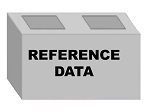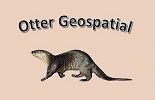When I’m working with students on project specific GIS skills, I try to draw them into a “let’s build something together” dynamic. That means we downplay the memorizing of rules and keystrokes and focus on the fact that GIS software is a tool for building a tangible product that serves a very specific purpose. An example would be the geographic information system we’re building to track vegetation management activities on UW-Green Bay’s natural areas. We promote the “building something” idea by referring to the components of a typical geographic information system as its building blocks.
Local, State and Regional Data on the Internet
Municipal and state governments are rich sources of reference data as well as academic institutions and non-government organizations.
- GIS datasets in the form of download portals and/or map services
- Ungeoreferenced images (photos, scanned maps etc.)
- Documents created in office software (tables, text reports etc.)
We’ve pulled together a modest sampling CHECK IT OUT
North American and World Data on the Internet
- GIS datasets in the form of download portals and/or map services
- Ungeoreferenced images (photos, scanned maps etc.)
- Documents created in office software (tables, text reports etc.)
We’ve pulled together a modest sampling CHECK IT OUT
The Cofrin Center for Biodiversity’s Geodata Archive
In response to the needs of natural sciences faculty and students, the Cofrin Center for Biodiversity has been collecting and storing spatial data since 2003. The scope and design of the CCB’s spatial data library has evolved over time and it is currently referred to as the “Geodata Archive”. The table below lists the seven distinct collections that comprise the Biodiversity Center’s Geodata Archive:
- GISFIX-01 Master Archive – A curated collection containing about 30,000 “ArcMap-ready” datasets.
- GISFIX-01 (Geodata Drive Subset) – 18,000 or so datasets selected for relevance to research and classroom activities.
- GISDUMP-01 Master Archive – 300 or so “might be useful someday” filesets.
- GISJOB-01 Master Archive – job-specific files from 400 or so completed jobs.
We’ve published a number of articles on the contents and status of the Geodata Archive. CHECK IT OUT

Internet
Data Resources
———-
UW-Green Bay
Data Resources
———-
Text Reports &
Tabular Data
———-
Air Photos &
Scanned Maps
